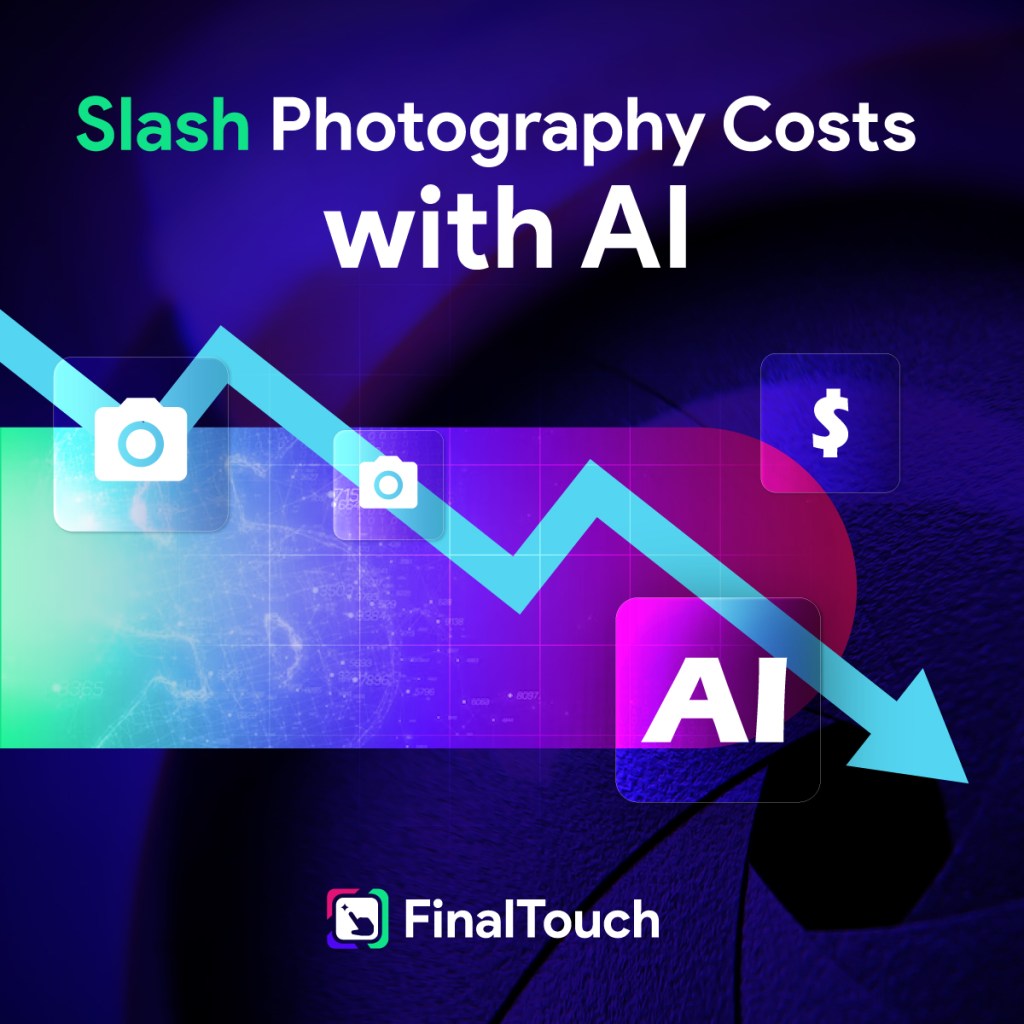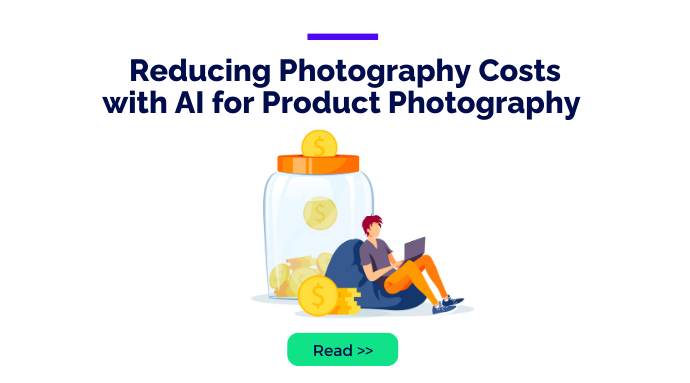What is the cost of product photography, from shoot to publication?
It can be hard to calculate, but for almost every eCommerce brand, it’s a significant expense. But generative AI makes it possible to produce a large number of images and reduce the cost per image.
Forward-thinking brands are already adopting AI for product photography, cutting costs and improving efficiency.
Let’s take a look at those benefits and find out what is possible when businesses invest in the right AI photography tools.
How Much Does Photography Actually Cost in 2024?
High quality product photography is an investment in the success of your online business. Product photographs can make the difference between converting potential customers and losing them to your competitors. And like any investment, conventional product photography comes with significant costs.
These include fees for professional photographers and rates for specialized photography studios. Post production adds another layer of expense, not to mention the time and effort it takes for your internal teams to coordinate with independent photographers and conduct quality assurance.
Product photography rates vary widely, but here is an outline of what you can expect as an eCommerce owner:

Different Pricing Structures
Most product photographers offer a range of options. Choosing the right one depends on the specifics of your products and the volume of photos you need.
Pricing per Hour: Hiring a photographer or studio on an hourly basis can cost anywhere from $20 to $500 per hour, depending on the photographer’s expertise and location.
Pricing per Day: Renting a photography studio on a daily basis typically ranges from $400 to $1,000. Additional costs may apply for equipment and props.
Pricing per Product: If you have a large number of similar products, pricing per product may be a cost-effective option. Prices can vary from $20 to $100 per product.
Pricing per Image: Paying per image can range from $1 to $50. This model is beneficial for businesses that need multiple images per product.
Additional Factors Affecting Pricing
Product Category: More complex products can be more difficult to photograph. For example, electronics or machinery may require specialized equipment and knowledge, leading to higher costs.
Volume of Photos: The more images needed for your product range, the higher the cost. Large catalogs with many products will naturally incur more expenses.
Complexity of the Shoot: If you need complex lighting setups, multiple angles, and intricate styling, the cost of a shoot can escalate quickly. These costs are hard to avoid, because consumers and eCommerce platforms favor image catalogs that offer variety.
Photographer’s Experience: Like any service, you get what you pay for when it comes to product photos. It’s important to find skilled photographers with experience in the types of photography that make sense for your products. Of course, the more skilled the photographer, the more they will charge.
Cost Reductions in Product Photo Creation and Maintenance
As we have seen, traditional product photography is a complex process, with costs at each step:
- Renting a professional studio and setting up photoshoots with props.
- Investing in photography equipment for shoots and post shoot processing.
- Paying hourly rates for product photographers to use the settings and equipment.
Whether you’re selling on Amazon, your website, social media, or all three – cutting corners on quality simply isn’t an option. For example, Amazon product photography guidelines require high resolution, proper lighting and multiple angles – all of which increase the cost of a shoot.
These costs add up quickly. This is especially true for brands with large product catalogs. They need a way to present each product in scenes that are both attractive and informative. These scenes need to give customers a clear vision of how the product will benefit them.
For a long time, eCommerce brands have needed a way to streamline and simplify these processes. That solution is now here, and it is making product photography more cost effective as well as more efficient.
Doing More with Less: Using AI for Product Photography Replaces Most Expensive Steps in the Process
Using AI for productivity gives businesses a way to side-step the costs of photoshoots and multiple rounds of editing. And it also allows teams to be more agile.
Need a new setting to showcase your product? Or remove visual noise and replace it with a clean white background? Simply use an AI photo generator that has this option in line with your requirements. With FinalTouch, you can do all of this in a few clicks.
The platform takes images of your product and automatically generates complete product scenes that look like the result of a professional photo shoot. With a variety of settings to choose from, you can transport your products virtually from the living room to the outdoors, with naturalistic shadows and details, sized in proportion to their surroundings.
You no longer need to set up a new shoot and recapture your images to refresh your catalog. Instead, it all takes place in a matter of seconds, with beautiful images ready to go. The result is more agile and cost-effective marketing.
Automating Catalog Maintenance and Updates
These efficiency gains also extend to maintenance and updates. With FinalTouch’s new holiday scene feature, it’s possible to quickly implement seasonal product updates. Your team can run holiday promotions without repeating the process of product photography.
This makes a big difference during sale seasons, when eCommerce teams are under a lot of pressure. In the past, they would have to create new images and backgrounds. But now, they can upload existing photos and generate new product scenes appropriate for the time of year. Keeping your digital product catalog fresh and relevant has simply never been so easy.
The Impact of AI-Generated Images on Efficiency for Creatomg Product Photography
Efficiency is key eCommerce success. Generative AI solutions like FinalTouch enable in-house to spend much less time on manual image creation. This allows them to focus on other business-critical goals. These include developing new products, engaging with customers, and building effective marketing strategies.
Calculating Return on Investment (ROI) for Using Generative AI in eCommerce
Investing in generative AI for product photography has many benefits in addition to lower production costs. It’s a smart strategic move that can yield an excellent return on investment. According to one study, 66% of marketers using generative AI reported a positive ROI, with many reporting up to 3X.
Here are the factors that go into assessing the impact of AI in product photography:
- Cost savings from reduced photoshoots, retouching, and editing expenses.
- Increased efficiency due to streamlined image creation and one-click seasonal updates.
- Enhanced customer experience, leading to higher conversion rates and customer loyalty.
By empowering eCommerce brands with these benefits, sophisticated AI product photo generators are leveling the playing field. It’s now possible for smaller businesses to compete with much larger ones, even if they can’t match their product photography budgets.
FinalTouch: Generative AI Built for Ambitious eCommerce Brands
Investing in AI for product photography is a strategic move that leads to significant cost savings and efficiency gains.
At FinalTouch, we’re committed to helping eCommerce brands get the most out of this exciting new development. Our platform combines cutting-edge AI technology with maximum ease of use to generate product photos at scale. And we regularly update it with new features based on user feedback and requests.
Sign up for free early access for a front row seat to the next big thing in AI product image generation.
